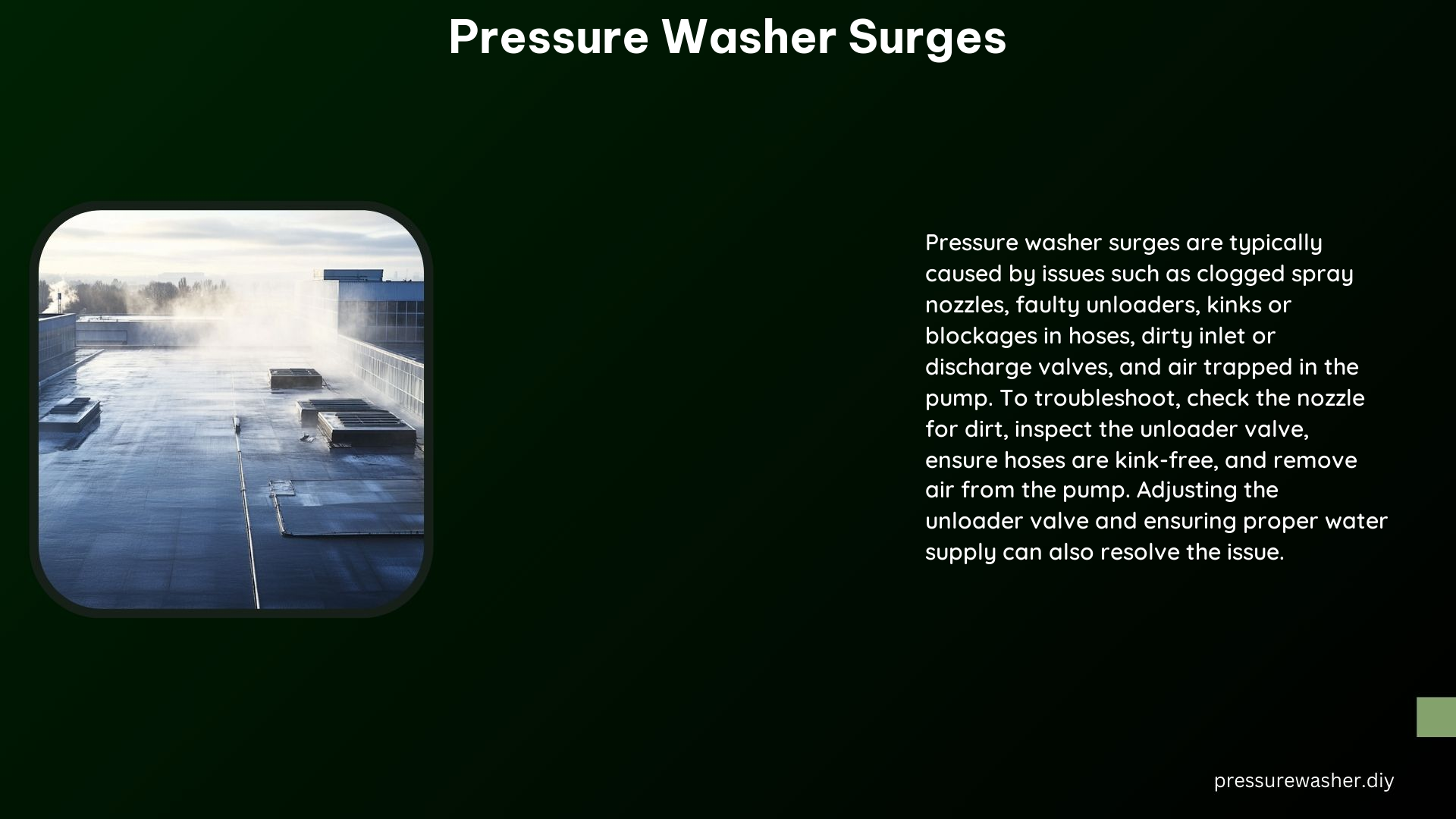Pressure washer surging, also known as pulsing, refers to an inconsistent flow of water from the pressure washer, resulting in inefficient cleaning and potential damage to surfaces. This phenomenon can be caused by various issues, including kinks and blockages, plugged nozzles, dirty valves, faulty pressure regulators, worn pump seals, air in the pump, and fuel problems. To help you diagnose and fix these issues, we’ve compiled a comprehensive guide with technical specifications and step-by-step solutions.
Causes of Pressure Washer Surging
1. Kinks and Blockages
Kinks or blockages in the hose or pump can restrict water flow, leading to surging. The pressure washer hose should be free of any kinks, bends, or obstructions, and the pump inlet and outlet should be clear of debris. Inspect the hose for any signs of wear or damage, and replace it if necessary. Additionally, check the pump’s inlet and outlet filters for any blockages and clean or replace them as needed.
2. Plugged Nozzle
A clogged spray nozzle can cause surging by restricting the water flow. The nozzle should be cleaned regularly to prevent buildup of dirt, debris, or mineral deposits. If the nozzle is severely clogged, it may need to be replaced. Typical nozzle orifice sizes range from 0.25 to 0.50 inches (6.35 to 12.7 mm) in diameter, and the flow rate can vary from 0.5 to 5 gallons per minute (1.9 to 18.9 liters per minute) depending on the pressure washer model.
3. Dirty Inlet or Discharge Valve
Dirty valves can disrupt the water flow, leading to surging. The inlet and discharge valves should be inspected and cleaned regularly. Typical valve materials include stainless steel, brass, or ceramic, and the valve seats are often made of rubber or other elastomeric materials. The valve clearance should be within the manufacturer’s specifications, typically ranging from 0.002 to 0.010 inches (0.05 to 0.25 mm).
4. Faulty Pressure Regulator
A malfunctioning pressure regulator can cause pressure fluctuations, resulting in surging. The pressure regulator is responsible for maintaining a consistent output pressure, and if it is not functioning correctly, it can lead to unstable water flow. Pressure regulators are typically rated for a maximum pressure range of 1,000 to 5,000 PSI (69 to 345 bar), with an accuracy of ±5% to ±10% of the set pressure.
5. Worn Pump Seals
Worn or damaged pump seals can allow air to enter the pump, causing surging. The pump seals are responsible for maintaining the proper water flow and pressure, and if they are worn or damaged, they can allow air to be drawn into the pump, disrupting the water flow. Pump seals are typically made of materials like Viton, PTFE, or nitrile rubber, and they should be replaced according to the manufacturer’s recommended service intervals, which can range from 50 to 500 hours of use.
6. Air in the Pump
Trapped air in the pump or hose can disrupt the water flow, leading to surging. This can be caused by a variety of factors, such as a leak in the suction line, a faulty check valve, or a problem with the water supply. To remove air from the pump, disconnect the hose and let the water flow freely until the air is purged. The pump should be designed to handle a maximum suction lift of 10 to 25 feet (3 to 7.6 meters) of water, depending on the model.
7. Fuel Problems
In pressure washers with small engines, clogged carburetors or fuel issues can cause surging. The engine’s fuel system should be inspected and cleaned, and the carburetor should be adjusted according to the manufacturer’s specifications. Typical carburetor jet sizes range from 0.020 to 0.045 inches (0.51 to 1.14 mm) in diameter, and the fuel flow rate should be within the engine’s recommended range, typically 0.5 to 2.0 gallons per hour (1.9 to 7.6 liters per hour).
Fixing a Surging Pressure Washer

To fix a surging pressure washer, follow these steps:
- Check the Nozzle: Clean or replace the nozzle if it is clogged. Ensure the nozzle orifice size matches the pressure washer’s recommended specifications.
- Inspect the Unloader Valve: Clean or replace the unloader valve if it is restricted. The unloader valve is responsible for diverting water flow when the trigger is released, and a malfunctioning valve can cause surging.
- Check the Hose and Filter: Ensure the hose is free of kinks and blockages, and clean or replace the filter if necessary. The hose should be rated for the pressure washer’s maximum operating pressure, typically ranging from 2,000 to 4,000 PSI (138 to 276 bar).
- Check the Water Supply: Ensure the water supply is sufficient and the pump is receiving enough water. The water flow rate should match the pressure washer’s recommended range, typically 2 to 5 gallons per minute (7.6 to 18.9 liters per minute).
- Check for Air in the Pump: Disconnect the hose and let the water flow to remove any trapped air. The pump should be designed to handle a maximum suction lift of 10 to 25 feet (3 to 7.6 meters) of water.
- Adjust the Unloader Valve: Adjust the unloader valve to find the optimal setting for maximum pressure and minimal pressure spikes. The unloader valve should be set to the manufacturer’s recommended pressure, typically between 1,500 and 3,000 PSI (103 to 207 bar).
- Check the Governor and Carburetor: If the pressure washer has a small engine, inspect the governor and carburetor for any issues. The governor should maintain a consistent engine speed, and the carburetor should be properly adjusted to provide the correct fuel-air mixture.
By following these steps and addressing the specific issues that are causing the pressure washer to surge, you can restore consistent and efficient water flow, ensuring optimal cleaning performance and preventing potential damage to surfaces.
References
- Bisongenerator. (2023, November 3). Pressure washer surging/pulsing: An in-depth comprehensive guide. Retrieved from https://www.bisongenerator.com/Blog/pressure-washer-surging-pulsing.html
- Garage Journal. (2018, October 28). Pressure washer “surge” question. Retrieved from https://www.garagejournal.com/forum/threads/pressure-washer-surge-question.405142/
- Bison Industry. (2023, November 2). Pressure washer surging/pulsing (How to fix it?). Retrieved from https://www.bisonindustry.com/news/pressure-washer-surging-pulsing/
- Reddit. (2023, June 1). What is causing my pressure washer to surge? Retrieved from https://www.reddit.com/r/smallengines/comments/13xvk9m/what_is_causing_my_pressure_washer_to_surge/
- Francis Rose. (2020, March 28). 6 Problems That Cause Pressure Washer Surging. Retrieved from https://francisrose.co.uk/the-causes-of-pressure-washer-surging/
